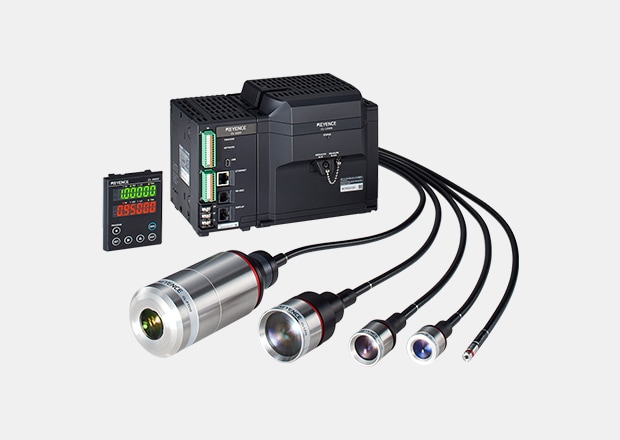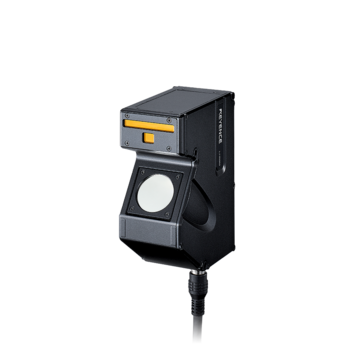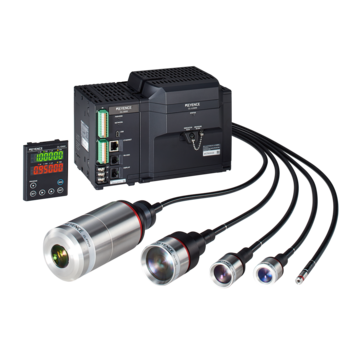Measurement Sensors
- 2D/3D Laser Profiler LJ-X8000 series
- High-speed 2D Laser Profiler LJ-V7000 series
- 2D Laser Displacement Sensor LJ-G5000 series
- Confocal Displacement Sensor CL-3000 series
- Ultra High-Speed/High-Accuracy Laser Displacement Sensor LK-G5000 series
- High-Speed, High-Accuracy CCD Laser Displacement Sensor LK-G3000 series
- Image-Based Laser Sensor IX series
- CMOS Multi-Function Analog Laser Sensor IL series
- Telecentric Measurement System TM-X5000 series
- High-speed optical micrometer LS-9000 series
- High-speed 2D Optical Micrometer TM-3000 series
- High-speed, High-accuracy Digital Micrometer LS-7000 series
- Multi-Purpose CCD Laser Micrometer IG series
- Thrubeam Type Laser Detection Sensor IB series
- 3D Interference Measurement Sensor WI-5000 series
- Micro-head Spectral-interference Laser Displacement Meter SI-F series
- Spectral-Interference Wafer Thickness Meter SI-F80R series
- High-speed, High-Accuracy Digital Displacement Inductive Sensor EX-V series
- Inductive Gauging Sensor AS series
- High-accuracy Positioning Sensor EG series
- High-Accuracy Digital Contact Sensor GT2 series
- General Purpose Digital Contact Sensor GT series
Dimension Measurement
Displacement Measurement
- Measurement Sensors for the Medical and Pharmaceutical Industry
- Measurement Sensors for the Fiber Optic/Cable Industry
- Measurement Sensors for the Film and Sheet Industry
- Measurement Sensors for the Electric Vehicle Industry
- Measurement Sensors for the Semiconductor Industry
- Measurement Sensors for the Electronics Systems Industry
- Measurement Sensors for the Food and Beverage Industry
- Measurement Sensors for the Automotive Manufacturing Industry
- Measurement Sensors for the Metal and Steel Industry
2D Profile Measurement
When looking for the best way to perform profile measurements, there are several important factors to consider, including the type of measurement system and the installation environment. Selecting equipment that doesn't adequately meet your needs can lead to insufficient precision and increased man-hours during production.
This site is designed to help users determine the best way to perform measurements with confidence regarding a 2D profile measurement system.
2D Profile Measurement: How to Measure 2D Shapes
2D profile measurement relies on capturing the shape's dimensions, contours, 2D measurements, and other physical properties—such as flatness—in two-dimensional space using 1D or 2D laser displacement sensors in a single scan. Using displacement laser technology allows for exceptionally efficient dimensional mapping of complex shapes or instances that require real-time 2 dimensional profiling. Accurate measuring starts with a clear understanding of the process, which includes selecting an adequate measuring system, adequate calibration of measuring tools, positioning, data capture, and data analysis.
For this guide, we'll focus solely on the selection of the appropriate measuring systems, which depend on the specific requirements of your project—or, in other words, which type of laser displacement sensor you should use.
2D Measurements of Shapes Using 1D Laser Displacement Sensors

2D Profile measurement of aluminum fins
1D laser displacement sensors are specifically designed to measure the distance from the sensor to the target surface. In their most basic setup, 1D laser displacement sensors work by creating a series of 1D measurements, which are then compiled into a 2D profile.
During scanning, the sensor projects a laser beam towards the target surface, which then reflects the light back to the sensor. The sensor calculates the distance based on the angle of reflection or properties of the light returned to the sensor, based on sensor used. As stated above, measuring a 2D profile is done either by moving the sensor or the object being measured. This allows the laser sensor to take a series of 1D measurements and form a 2D profile of the object.
Their ability to measure the distance between the sensor and the surface makes them perfect for gauging changes in height or detecting surface irregularity. So, if your primary concern lies in measuring variations in flat or slightly curved surfaces, a 1D sensor might be sufficient. An example application would be measuring a 2D profile of aluminum fins.

Optimal Measurement System Laser Displacement Sensor
Shapes are measured by moving the target or sensor head to accumulate height data.
- Shapes can be measured at a higher precision with 1D laser displacement sensors than with 2D laser displacement sensors.
- A mechanism for moving the sensor head and/or target is required.
- Vibrations from when the sensor head or target is moved cause measurement errors.

Confocal Displacement Sensor CL-3000 Series
High-precision measurement on all targets, with simple sensor head installation and program settings. CL-3000 Series ultra-compact coaxial laser displacement sensors address manufacturing challenges such as improving quality, preventing the shipment of defective parts and increasing production.
Click here for more details
- Multi-color confocal method
- Linearity:From ±0.2 µm
- Confocal displacement sensor

Micro-head Spectral-interference Laser Displacement Meter SI-F Series
Introducing the world’s first micro-head, with the highest measurement accuracy in its class and a level of performance that was previously thought impossible. These micro-head sensors can be used to measure the thickness and warpage of high-precision objects such as silicon wafers.
Click here for more details
- Spectral interference method
- Ultra-high resolution of 1 nm
- 2 mm microprocessor sensor head
2D Profile Measurement of Shapes Using a 2D Laser Displacement Sensor

Profile measurement of tire tread grooves
Things aren't as simple when it comes to capturing and measuring objects with intricate details or complex contours. And that's where 2D Laser Displacement Sensors come in. Instead of emitting a single point like 1D laser displacement sensors do, 2D laser displacement sensors project a line onto the target surface.
The laser line is reflected off the surface and picked up by the built-in receiver system, which then processes the shape of the reflected line to the object's 2D profile by using cutting-edge algorithms. This allows the 2D displacement laser sensor to capture an entire 2D profile of an object in a single scan, without movement. A good example of this would be profile-measuring tire tread grooves.

Profile measurement of tire tread grooves
Optimal Measurement System 2D Triangulation Laser Displacement Sensor
The cross-sectional shape of locations where the laser hits can be obtained. High-speed sampling makes it possible to achieve stable detection even if the workpiece moves.
- Shapes can be measured without moving the sensor head and target.
- The shape of large targets can be measured by installing multiple sensor heads.

2D/3D Laser Profiler LJ-X8000 Series
LJ-X laser profilers collect height data across a laser line rather than a single point. This enables 2D/3D measurements such as height difference, width, or angle to be performed using a single sensor.
Click here for more details
- 2D triangulation method
- In-line multi-point measurement
- World's fastest sampling rate at 64,000 images/sec

Confocal Displacement Sensor CL-3000 Series
High-precision measurement on all targets, with simple sensor head installation and program settings. CL-3000 Series ultra-compact coaxial laser displacement sensors address manufacturing challenges such as improving quality, preventing the shipment of defective parts and increasing production.
Click here for more details
- Multi-color confocal method
- Linearity:From ±0.2 µm
- Confocal displacement sensor
What is 2D Profile Management?
Both 1D and 2D laser displacement sensors use various software tools to analyze the collected data and present it as a coherent 2D profile of a target surface. Not only that, but the softwares also provide detailed information that can be used to identify potential issues and anomalies.
And that's where 2D profile management comes into play, as it centers on harnessing the said data's potential. This involves storing the analyzed data about a particular 2D profile, setting benchmarks that are compared to future scans and 2D measurements, and allowing easier quality control and maintenance—including calibrations and maintenance of the measuring system itself.
Related Downloads
![Key Technology and Application [Profile measurement]](/img/asset/AS_108927_L.jpg)
Conventionally, profile measurement and 3D measurement have been difficult to perform inline. This guide uses practical examples to explain how accurate, high-definition measurement and inspection can be easily achieved with the latest laser profilers.
Related Products
Applications
Dimension Measurement
Displacement Measurement
Profile Measurement
Industries
- Measurement Sensors for the Medical and Pharmaceutical Industry
- Measurement Sensors for the Fiber Optic/Cable Industry
- Measurement Sensors for the Film and Sheet Industry
- Measurement Sensors for the Electric Vehicle Industry
- Measurement Sensors for the Semiconductor Industry
- Measurement Sensors for the Electronics Systems Industry
- Measurement Sensors for the Food and Beverage Industry
- Measurement Sensors for the Automotive Manufacturing Industry
- Measurement Sensors for the Metal and Steel Industry


